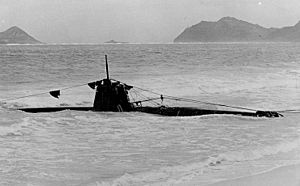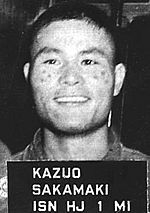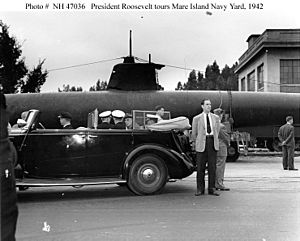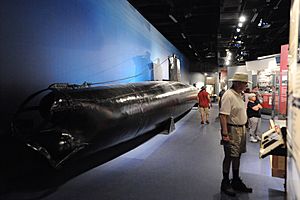HA. 19 (Japanese Midget Submarine) facts for kids

HA. 19 grounded in the surf on Oahu after the attack on Pearl Harbor, December 1941
|
|
Quick facts for kids History |
|
|---|---|
| Name | HA. 19 |
| Builder | Kure Naval Dockyard, Kure |
| Launched | 1938 |
| Captured | Grounded, Oahu 7 December 1941 |
| Status | Museum Exhibit |
| General characteristics | |
| Type | Type A Kō-hyōteki-class submarine |
| Displacement | 46 long tons (47 t) submerged |
| Length | 23.9 m (78 ft 5 in) |
| Beam | 1.8 m (5 ft 11 in) |
| Height | 3 m (9 ft 10 in) |
| Propulsion |
|
| Speed |
|
| Range |
|
| Test depth | 30 m (98 ft) |
| Complement | 2 |
| Armament |
|
|
HA. 19 (Japanese Midget Submarine)
|
|
| Location | National Museum of the Pacific War, 340 E. Main St., Fredericksburg, Texas |
| Area | 0.1 acres (0.040 ha) |
| NRHP reference No. | 89001428 |
| Significant dates | |
| Added to NRHP | June 30, 1989 |
| Designated NHL | June 30, 1989 |
The HA. 19 was a special type of small submarine called a midget submarine. It belonged to the Imperial Japanese Navy. This submarine was part of the Japanese attack on Pearl Harbor on December 7, 1941.
Its crew had a mission: to enter Pearl Harbor and attack American warships. They planned to use two torpedoes and then sink their own submarine with explosives. However, the crew faced many problems. They could not get into the harbor. The submarine ran aground (got stuck) and was later captured by American forces.
Today, the HA. 19 is on display. You can see it at the National Museum of the Pacific War in Fredericksburg, Texas.
Contents
Building the HA. 19
The HA. 19 was built in 1938. It was made at the Kure Naval Dockyard in Kure, Hiroshima, Japan. It was a Type A Kō-hyōteki-class midget submarine. A special viewing device, called a Type 92 periscope, was added later in May 1941.
Mission to Pearl Harbor
In November 1941, the HA. 19 was part of a large Japanese fleet. This fleet was called the Kido Butai. The HA. 19 was carried by a larger submarine, the I-24. This larger submarine was its "mother ship."
The HA. 19 had a crew of two men. They were Ensign Kazuo Sakamaki and CWO Kiyoshi Inagaki.
The Journey Begins
On December 7, 1941, at 3:30 AM, the HA. 19 was launched from its mother ship. Its compass, which helps with direction, was broken. The crew had about four and a half hours to reach Pearl Harbor. They tried to fix the compass while they were on their way.
Trouble at the Harbor
The HA. 19 got close to the harbor entrance. But because the compass was not working, it hit a reef (an underwater rock formation) three times. At 8:00 AM, it got stuck on the right side of the entrance.
The main attack on Pearl Harbor was already happening. At 8:17 AM, the stranded submarine was seen by the American ship USS Helm. Inagaki quickly made the submarine dive underwater. When it came back up at 8:19 AM, the destroyer saw it again. The destroyer fired, but missed. However, the blast pushed the HA. 19 off the reef. This caused Sakamaki to become unconscious. Inagaki dived the submarine again to escape.
A Difficult Escape
When Sakamaki woke up, the crew tried again to enter the harbor. But the submarine was damaged from hitting the reef. One of its torpedoes could not be fired. Water was slowly leaking into the submarine, and the batteries were giving off harmful fumes.
They hit the reef again while trying to enter. They backed up and tried once more. On the next try, it got stuck again, but came free after they adjusted the weight inside. On their final attempt, the HA. 19 was hit by depth charges. These explosions made it impossible to fire the other torpedo. The periscope was also damaged.
The crew decided to stop the attack and return to their mother ship. The fumes from the batteries made them pass out. When they woke up, it was night. They planned to get the submarine to Waimānalo shore. But the engine stopped, and the submarine got stuck on a reef offshore.
Sakamaki told Inagaki to leave the submarine. Sakamaki then tried to set an explosive charge to sink the submarine. But the charge did not go off, probably because it was wet. Sakamaki swam to shore and was captured the next day. Sadly, Inagaki drowned.
Discovery and Capture
The Americans called the HA. 19 "Midget C." This was because it was the third midget submarine they had seen. On December 8, 1941, American planes bombed the abandoned HA. 19. The bombs missed, but the submarine broke free. It then washed onto the beach.
In the days after the attack, the submarine was pulled out of the sea. An Army tractor helped with this. The HA. 19 was designed to be taken apart into three pieces. This feature was used to move it without destroying it. It was taken to the Naval Submarine Base Pearl Harbor. There, experts studied it. They found out that most of the damage was from hitting the reef many times.
A Submarine on Tour
In September 1942, the HA. 19 was sent to the U.S. mainland. It went on tours to help sell war bonds. These bonds helped pay for the war. The submarine was at Navy Pier in Chicago, Illinois, when the war ended.
From War to Museum
On January 20, 1947, the HA. 19 was put on display outdoors. It was at Naval Station Key West in Key West, Florida. Later, on December 2, 1964, it was moved to an outdoor exhibit. This was at the Key West Lighthouse and Military Museum.
On June 30, 1989, the HA. 19 was listed as a U.S. National Historic Landmark. This means it is a very important historical site.
In 1990, the Key West museum decided to focus only on lighthouses. So, they started to get rid of their military items. In 1991, the HA. 19 was moved to Fredericksburg, Texas. It became part of the National Museum of the Pacific War. That same year, Kazuo Sakamaki, one of the submarine's original crew members, visited the museum. He was reunited with his submarine.








